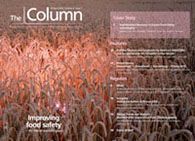Collaboration extension
It has been revealed that the collaboration between Thermo Fisher Scientific?s Biomarker Research Initiatives in Mass Spectrometry (BRIMS) Center and three organizations will be extended.
It has been revealed that the collaboration between Thermo Fisher Scientific’s Biomarker Research Initiatives in Mass Spectrometry (BRIMS) Center and three organizations will be extended.
Over the last couple of years, the BRIMS Center, George Mason University’s Center for Applied Proteomics and Molecular Medicine (CAPMM), Johns Hopkins University and Toronto’s University Health Network (UHN) have collaborated to speed up protein biomarker identification for cancer and other diseases. The results of this collaboration were recently demonstrated at the US Human Proteome Organization 2010 meeting in Denver, Colorado, USA.
To address the challenges set out by biomarker researchers seeking to independently validate hypothetical biomarkers and routine mass spectrometry-based quantitative assays suited for clinical research, the BRIMS Center developed targeted SRM-based quantitative mass spectrometry workflows that allow rapid assay development and cross validation of biomarker assays across the network of laboratories. Each of the collaborators uses these biomarkers and assays to perform research on identical Thermo Scientific TSQ Quantum Ultra triple quadrupole mass spectrometry platforms.
The director of the BRIMS Center, Mary Lopez, stated, “Working together, the BRIMS Center and the collaborators demonstrated an instrument platform and an end-to-end workflow from sample preparation through data analysis that are easily and reproducibly transferred from laboratory to laboratory. By continuing our work with these leading research groups, we can extend their ground-breaking research by continuing to apply the SRM-based workflow to previously validated clinical biomarkers.”
This study is reportedly the first inter-lab study to demonstrate reproducible determination of protein abundance in a complex matrix such as blood.
For more information visit Thermo’s website at www.thermo.com/proteomics
This story originally appeared in The Column. Click here to view that issue.

Polysorbate Quantification and Degradation Analysis via LC and Charged Aerosol Detection
April 9th 2025Scientists from ThermoFisher Scientific published a review article in the Journal of Chromatography A that provided an overview of HPLC analysis using charged aerosol detection can help with polysorbate quantification.
Analyzing Vitamin K1 Levels in Vegetables Eaten by Warfarin Patients Using HPLC UV–vis
April 9th 2025Research conducted by the Universitas Padjadjaran (Sumedang, Indonesia) focused on the measurement of vitamin K1 in various vegetables (specifically lettuce, cabbage, napa cabbage, and spinach) that were ingested by patients using warfarin. High performance liquid chromatography (HPLC) equipped with an ultraviolet detector set at 245 nm was used as the analytical technique.
Removing Double-Stranded RNA Impurities Using Chromatography
April 8th 2025Researchers from Agency for Science, Technology and Research in Singapore recently published a review article exploring how chromatography can be used to remove double-stranded RNA impurities during mRNA therapeutics production.











